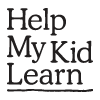What to do with this activity?
It's a good idea to have a traditional round-faced clock somewhere in your home to help your child learn to read the clock. Look at the clock together as part of your normal daily routine.
Talk about the time for different things your child does - “It’s half past eight, time for school”. Talk about hours, minutes and seconds. Challenge them to get dressed in under a minute, and count out loud in seconds. Give them fifteen minutes to complete a task. Have fun with time. Click on the Wikihow link for some good visuals and tips.
If your eight or nine year old is reasonably confident in telling the time from a clock face, here is a good game to play.
Have a look at digital clock too - point out which is the hour display, and which is the minutes display. Explain the difference between a 12 hour and a 24 clock. Instead of morning (am) or afternoon (pm) times, the hours are counted up after midday (12) until midnight (24).
-
Why am I doing this?
Everyday activities, like shopping and taking journeys provide a great opportunity for your child to practise maths skills by recognising patterns, counting out amounts, working out the best value, weighing and understanding money or understanding timetables and estimating your time of arrival!
-
How can I do more?
Estimating is a very useful maths skill for everyday life – helping you decide if you have enough money to pay for a number of items or enough paint to paint a room. Encourage your child to estimate, for example, how many potatoes you will need for dinner or how much money to buy the shopping.
Rate this activity
![]()
![]()
![]()
![]()
![]()
Based on 12 reviews
How would you rate it?
1 = Poor, 5 = Great.



